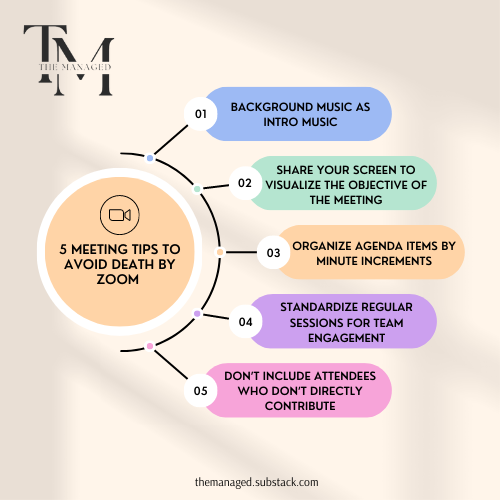5 Meeting Tips to Avoid Death by Zoom
A guide for hybrid engagement and how to be more effective in meetings
1. Background Music as Intro Music
Don’t force small talk. Rely on rotating songs as people log into the meeting. Ask for playlists, discuss themes for different projects or months, standardize how long a song plays before moving onto the agenda.
How to Get Started
Spotify or YouTube playlist + optimized audio sharing + testing
Tactics
1- Seasonal playlists for holidays and other occasions
2- Employee-sourced song suggestions
3- Project-based playlists
2. Share Your Screen to Visualize the Objective of the Meeting
Don’t depend on Zoom boxes to drive home your points. Display a simple slide with agenda items, an intriguing, interesting, or entertaining introductory image, the title of the meeting, an attendee list, or a mission statement to center attendees on the topic at hand.
How to Get Started
Use Google sheets or Powerpoint + share a slide with core meeting agenda + related media
Tactics
1- Standardize the slides used to set the agenda
2- Use images as much as words
3- Preview and test for viewability without narration
3. Organize Agenda Items by Minute Increments
With multiple contributors or in a discussion-based format, clearly list the increments in the meeting where the topic or speaker will change over and the topic to be covered.
How to Get Started
Create a document or slide or Excel sheet with contributor names - organize topics by priority and display allotted minutes (0:05, 0:10, etc.) Beside speaker name - explain expectations for speakers and potential commenters.
Tactics
1- Keep agenda items to 3 main priorities
2- Label agenda items with 3-8 words
3- Repeat agenda items to create common vernacular
4. Standardize Regular Sessions for Team Engagement
Team meetings should include contributions from the entire team about projects in the pipeline. Team members should come to meetings expecting to contribute according to a known schedule and agenda.
How to Get Started
Email or Slack to the meeting participants with a breakdown of what will be covered and who will be speaking 3-4 days prior to the meeting. Include this agenda in the meeting description and send a reminder 1-2 days before the meeting about what is expected.
Tactics
1- Make meeting descriptions more detailed to set expectations.
2- Schedule regular meetings for the same day and time every week with a standard name.
3- Encourage screen-sharing and documented plans with slides or memos that help enforce the team member’s contribution and allow for direct follow-up and next steps.
5. Don’t Include Attendees Who Don’t Directly Contribute
Optimize time management by eliminating any attendees who aren’t directly involved at the direct stage of the topic or project to be discussed and moved along. Standardize updates based on meeting next steps that include adjacent dependencies or stakeholders. If people are not relevant to a project or never contribute, don’t require attendance.
How to Get Started
Communicate who needs to be in the meeting and why. Reassess recurring meeting attendees and think about who needs to be there in order to keep the project moving. Build a standard follow-up process that includes secondary stakeholders rather than encourage attendance.
Tactics
1- Set clear expectations for guests who are “required” and guests who are “optional.”
2- Re-evaluate attendees based on changing priorities and projects at the end of each meeting and attach these communications to next steps.
3- Clarify that optional attendees are encouraged to join, but there is no expectation for them to attend. Experiment with how to differentiate primary attendees and secondary attendees, whether it is having primary attendees show video or announcing who are direct stakeholders in the project.
Keep Smiling,
Dhoreena





This is such great advice, really helpful stuff for avoiding Zoom death.